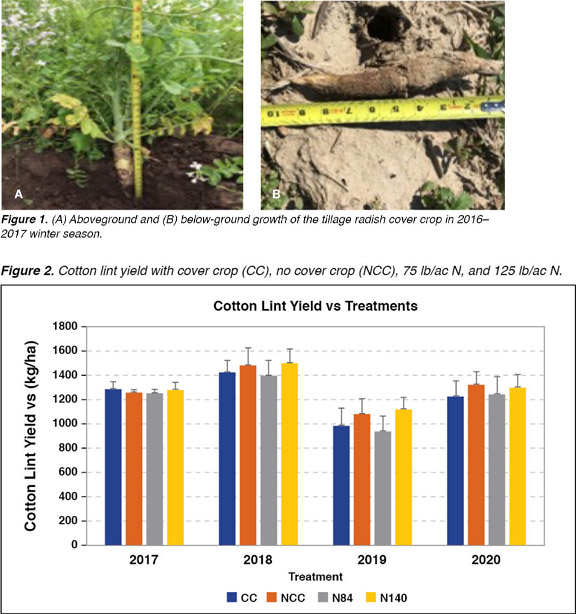Research Project
Nitrogen and Cover Crop Effect on Yield and Soil Water for Cotton and Corn
Investigators: Ruixiu Sui, Saseendran Anapalli, Gurpreet Kaur, Gurbir Singh
Date: 2021
Project Summary
Introduction
Tillage radish has been adopted as a cover crop by farmers for over a decade. The large and deep taproot of this crop can penetrate compacted soil layers by “bio-drilling” the crop root zone, which increases water infiltration into the soil, reduces surface runoff, and supports the subsequent crop by obtaining water and nutrients from deep soils. Because of its robust rooting system and rapid growth characteristics, a tillage radish cover crop can scavenge for residual nitrogen (N) in the soil, which can reduce excess N leaching into the groundwater. Optimizing N application rates and minimizing excess N leaching from crop production systems can help maximize farm profits and minimize environmental impacts. The objective of this study is to assess interacting effects of N rates and tillage radish cover crop on cotton and corn yield and soil water in the Mississippi Delta.
Materials and Methods
Field studies were conducted from 2017 to 2020 in cotton and 2021 in corn in Stoneville, MS. The field was approximately 12 acres and constituted one-half of the area under a center pivot irrigation system for sprinkler irrigation. The predominant soil map unit in the field was Commerce very fine sandy loam. Twelve plots were laid out in the field. Plots were 600 feet long and 75 feet (24 rows) wide. A 2 × 2 factorial experiment in randomized complete block design (RCBD) with three replications was used to test the effect of two N application rates (75 and 125 lb/ac N in cotton; 150 and 250 lb/ac N in corn) with tillage radish cover crop (CC) and with no cover crop (NCC) on crop yield and soil water. After cotton was harvested each year, cotton stalks were shredded using a rotary shredder. Then, the tillage radish cover crop was planted at a seeding rate of 8 lb/ac using a seed drill. Soil water sensors were used for irrigation scheduling. An irrigation was triggered as the percentage of plant available water dropped to approximately 50%. The cotton was picked using a cotton picker. The corn was harvested using a combine equipped with a yield monitor. Crop yield data were collected and analyzed.
Results and Discussion
The tillage radish cover crop grew very well in spring 2017 (Figure 1). The average TRCC height was about 24”. On average, the radish taproot was about 10” long and 2” in diameter. In 2018, 2019, and 2020, the cover crop did not grow as well as in 2017. One of the reasons for the poor growth in these seasons was that the radish suffered severe cold winter weather, which seriously damaged the plants and limited their growth in the subsequent spring seasons. We examined the soil water changes during the cotton growing season. Some increases in soil water content due to the tillage radish cover crop were evident. The higher soil water content in the CC plots could be due to the increase of rainwater infiltration and to enhanced soil physical properties, thus capturing and retaining more water in the soil profile. Lint yield responses to N rate and tillage radish cover crop are given in Figure 2 and Table 1. In general, the results showed that, compared to N rate of 75 lb/ac, the N rate of 125 lb/ ac could increase lint yield while the cover crop could decrease the lint yield. However, yield response to cover crop and N rate in 2017 did not follow that trend well. In 2017, the CC treatment had a higher lint yield than the NCC treatment, which was the reverse of the 2018, 2019, and 2020 seasons. The yield responding differently in 2017 could be caused by the residual N left in the field from the 2016 growing season. Corn yield data in 2021 is still being processed and will be reported later.
Conclusion
This study indicated that a tillage radish cover crop increased soil water infiltration capacity and enabled the soil to retain higher soil water content. Increasing N rate from 75 lb/ ac to 125 lb/ac could possibly increase cotton yield but needs further investigations to confirm. The non-significant impact of tillage radish cover crop on cotton yield could be caused by poor tillage radish growth as a result of cold temperatures and excessive winter rains. What we learned was that a tillage radish cover crop should be planted no later than the middle of October in this region to allow the plant to be well-developed prior to the cold winter weather for optimum regrowth in the subsequent spring.
Project Photos

- Crop Type:
- Cotton
- Corn
- Topic:
- Cover Crops
- Soil
Find Research
By Crop Type
By Topic
Contact NCAAR
General Information
Kaye Sullivan
vfs23@msstate.edu
662.390.8510
F:662.390.8501
Showcase Demo
Drew Gholson, Coordinator
drew.gholson@msstate.edu
662.390.8505
Himmy Lo
himmy.lo@msstate.edu
662.390.8509

